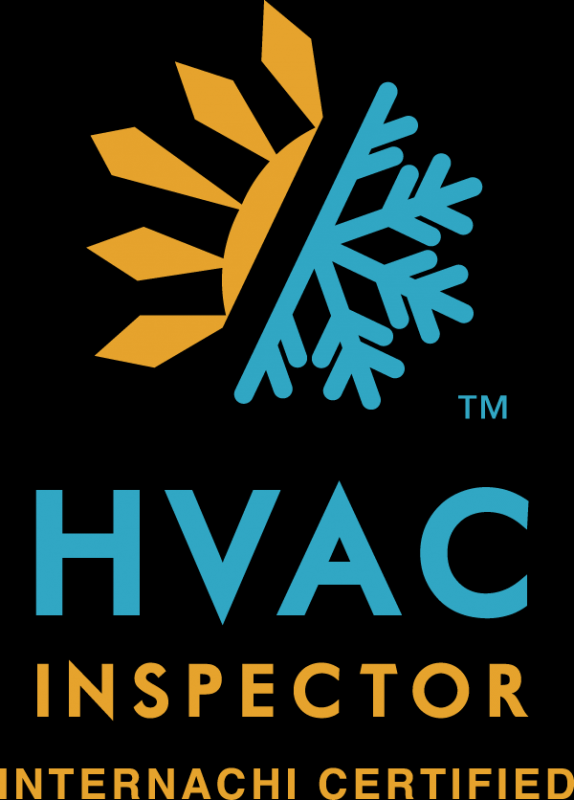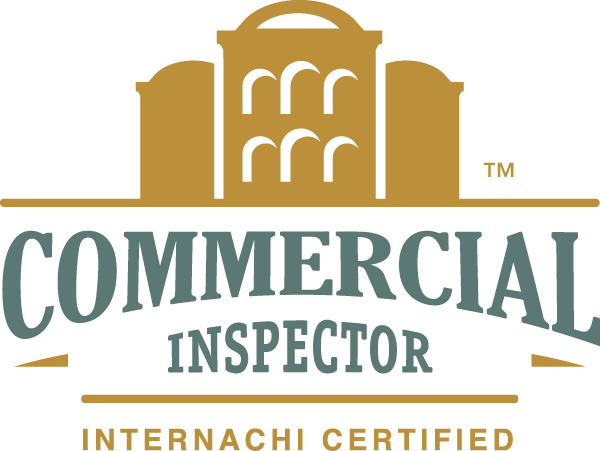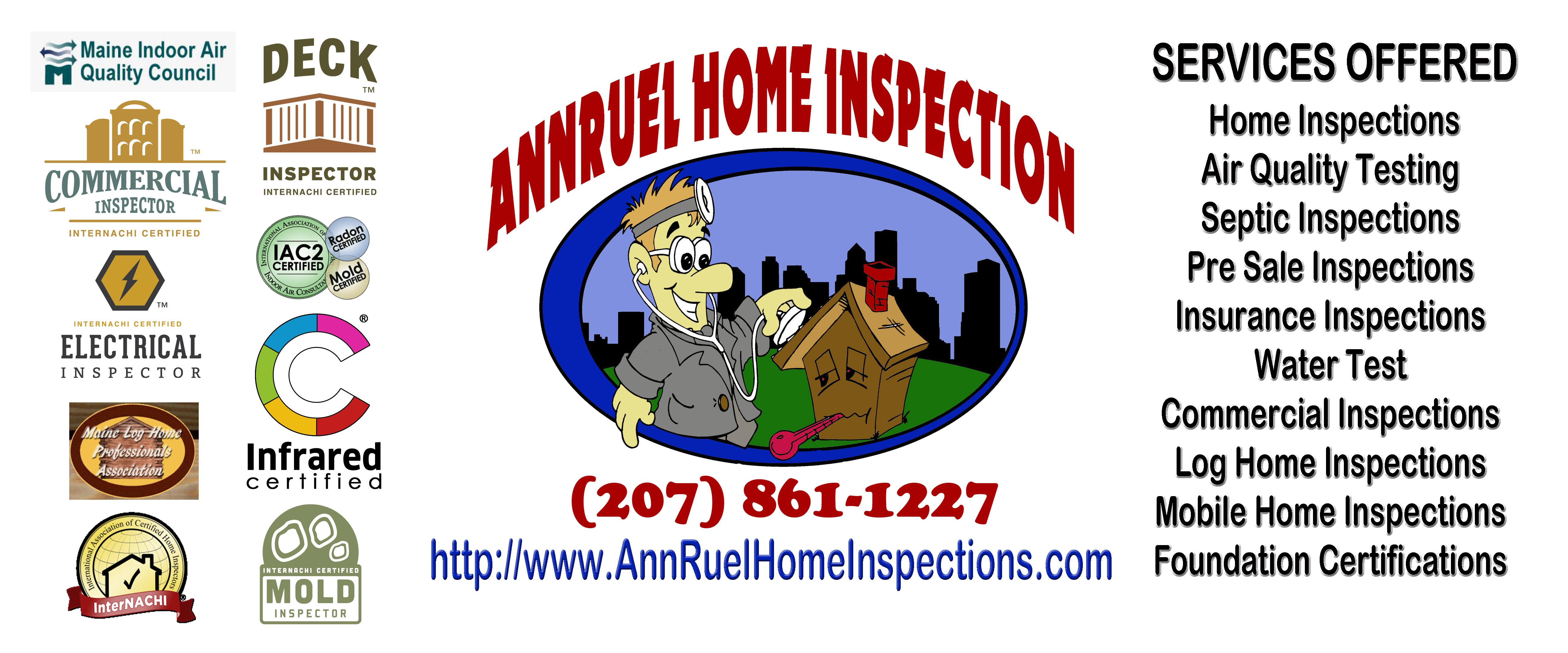Copyright 2016 James MacNaughton DBA AnnRuel Home Inspections11 Church Street Oakland, Maine (207) 861-1227
SERVICE AREA INCLUDES BUT IS NOT LIMITED TO... Albion Augusta Auburn Bangor Belgrade Belgrade Lakes Bowdoin Bowdoinham Bruinswick Burnham Canaan Cape Elizabeth Chelsea China Clinton Cornville Cumberland Detroit Dresden Durham Fairfield Farmingdale Fayette Falmouth Freeport Gardiner Gray Greene Hallowell Hartland Kents Hill Lewiston Lisbon Madison Manchester Monmouth Mount Vernon Newport New Gloucester Norridgewock Oakland Palermo Poland Portland Pittston Pittsfield Readfield Richmond Rome Sidney South Portland Skowhegan Somerville Smithfield St Albans TroyUnity Vassalboro Vienna Waterville Wayne Westbrook Whitefield Windsor Winslow Windham Winthrop
WATER TEST RESULTS
A HOME INSPECTION IS NOT A MOLD INSPECTION , AIR QUALITY INSPECTION , LEAD PAINT INSPECTION, RADON TEST, WATER TEST OR A WOOD DESTROYING ORGANISM INSPECTION. THESE SERVICES CAN BE ADDED IF YOU REQUEST THEM BEFORE THE INSPECTION AT AN ADDITIONAL COST. You can Expect your written Report within 72 hours from time of inspection A Home inspection helps eliminate a high percentage of risk when buying property, it does NOT eliminate all risk as often not everything can be seen and in no way is a guarantee




A home inspection is a limited, non-invasive examination of the condition of a home, often in connection with the sale of that home. Home inspections should only be conducted by a home inspector who has the internachi training and certifications to perform such inspections. The inspector prepares and delivers to the client a written report of findings. The client then uses the knowledge gained to make informed decisions about their pending real estate purchase. The home inspector describes the condition of the home at the time of inspection but does not guarantee future condition, efficiency, or life expectancy of systems or components. A home inspector is not expected to turn on water, electrical or heating: He is to verify that they are in working order or not at time of inspection. The inspector shall NOT lift carpeting; make holes in the ceilings, walls or floors. A Home inspection is Not a Mold Inspection or Air quality Inspection, if you are looking for a Mold or Air quality Inspection please see information on the Air Quality Page. If the Electricity, Water or Heat is not on when we arrive, we cannot inspect it. Anything unplugged or disconnected we cannot connect or plug it in. There is usually a reason something is unplugged.
YOUR HOME INSPECTION
What does a home inspector look for ?
Well here is what we look for


1) Arrive at the location, meet with the client or an agent, if contract hasnít been signed yet, I take care of that. Verify address
2) Walk around the driveway and walkways looking at the grounds, water drainage, overhanging trees and for any sink holes or hills in the yard and think about how will it drainage or land uses.
3) Walk around the house snapping pictures of all sides and all angles of the roof. Look for attic vents
4) look at the foundation to make sure there is at least 6 inches from the ground and the siding.
5) Inspect the foundation to see that any holes / windows / doors going into the basement or crawlspace is sealed to prevent water, insect or small animal intrusion. We are not structural engineers so we will give you our opinion for what it is worth and not a guarantee
6) Look at electrical meter to see if there is a good wire running to the ground rod.
7) Check any outside faucet drain away from the house
8) Check any outside lighting is secure and properly weather sealed.
9) Check that any outside outlets have a weather tight cover and are GFCI
10) Inspect the siding making note of any holes in the siding, broken sections or areas that need painting. If there are any moldy mildew areas that should be pressure cleaned and how water flow issues should be corrected that caused the mildew.
11) Inspect the drip cap, j channels, window head flashing, flange and all flashing around doors, windows and vent or other holes in the side of the house. Not all molds are dangerous and most homes will have some mold. If you are concerned with the mold Air quality please ask for a mold inspection added to your home inspection.
12) Check for any broken glass in the windows or fog in double insulated glass showing a leak or any caulking missing
13) Getting my ladder I now inspect the eaves and lift the roofing material to see that there is no more than 2 layers of roofing max and to check that the flashing looks in good condition.
14) Check all gutters
15) Inspect the roof checking the condition of the roof covering material and the flashing of chimneys or any other vent or item that protrudes through the roof.
16) Inspect any porches and decks to see that they are properly supported and attached to the house as well as several other items mentioned in a later chapter
17) Going inside I do a walk thru starting in the basement working with the thermal image camera to see if I notice any major air leaks or moisture.
18) I like to go right to the kitchen, check that every cupboard door and draw opens and closes ok. I tug on the cabinets to make sure they are firmly attached.
19) Turning on the sink I try the hot water check the temperature looking to see hot water around 110, I try the sprayer and garbage disposal if there is one.
20) With the water running I look under the sink, grip all pipes and see that they are secure.
21) Still under the cabinet I again use the thermal image camera and a moisture meter to check if there were any leaks under here and if so, if there is still any remaining moisture.
22) Note if there is no shut off valve under the sink as a minor issue
23) Checking the floor in front of the sink and around a dishwasher if there is one also with the moisture meter, below 20% in ok
24) Check the RH in the kitchen where between 30 to 60 is best
25) I look around the kitchen to see if there is a stove vent, smoke detector and any other type of ventilation.
26) I check any outlets that are within 6 feet from running water to make sure they are GFCI compliant.
27) Check all other outlets in the room.
28) Check the stove hood vent
29) Turn on the stove and oven checking with the digital thermometer to make sure that the oven reaches the temperature stated on control.
30) If it is a gas stove I check the lines and the stove with a gas leak detector.
31) We do Not run dishwashers or washing machines as sometimes they can leak and we could cause damage running them
32) Check the refrigerator and freezer to make sure it maintains a good working temperature.
33) Check any built in microwave to see if it leaks
34) Check any doors and windows in the room to see if they open and close ok
35) Walk around the entire floor to see if I feel any weak spots in the floor or any curling tiling
36) Moving into the bathroom I check windows and doors and for vent
37) Turn on the sink and shake pipes under counter to see they are secure
38) Use moisture meter under the sink note we do not do lead pain testing , if this is a concern please let us know so that we can advise you how to get a lead paint test.
39) Take off the back of the toilet bowl to see if inside looks ok
40) Grip the bowl and pull from side to side to see if it is loose or leaks.
41) Check the line on the bottom of the toilet bowl to make sure it is secure and no signs of previous leaks. Check also with meter.
42) Flush the toilet while running the sink and the bath tub, see if the tank refills properly. Average is within 60 seconds
43) Note if there is no shut off valve to the toilet as a minor issue
44) If there is an access panel behind the tub or shower that has easy access I look into it and check with moisture meter if there has been any leaks
45) I check an doors and draws in the cabinet
46) Check the caulking above the tub or shower
47) Try the shower or tub and see that it drains properly and that the hot water maintains a healthy temperature.
48) I check all outlets again within 6 feet of the running water need to be GFCI
49) Check floor for moisture lifting or sagging
50) Check if excess spray from shower has damaged the ceiling
51) Turn furnace up to 90 and when I go into each room I check to see if the temperature is within 5 degrees
52) Inspect basement walls for cracks or moisture issues
53) Check basement floor for cracks or leaks
54) Check that there is a sump pump
55) Check that wires and plumbing in the basement ceiling is secured and looks dry
56) Locate the water main shut off and often mark its location for buyer
57) Locate the interior main septic clean out
58) Open Electrical Panel and check wires are in correct amperage circuit breakers.
59) Check that any holes in panel are plugged
60) Inspect condition of box and wire types
61) Look for rodent or insects signs
62) Check hot water heater TPR valve runs to a drain pan
63) Check that there is a drip pan under the hot water tank
64) Water heater: no signs of rust, vented properly, sized to produce adequate
65) Inspect the water pump and that they water pressure valve says between 45 and 65 psi
66) Check the furnace to see that there are no leaks from fuel or water
67) Check for furnace emergency switch at top of stairs
68) Check furnace filter
69) Open chimney clean out and take a picture of the chimney flue
70) Check all stove pipe going into the chimney is secure and has no leaks
71) Check furnace and fuel tank is on cement footing
72) Check for any leaks around fuel tank
73) If accessible check random sill bolts
74) Check for insulation on sill
75) Check sealant around windows or vents
76) Check supports are fastened to ceiling and floor and are adequate to carry weight.
77) Check for any Spaulding on walls (leaks leak down, gasses weep up)
78) Check laundry area for any weak or wet areas
79) Check the hose lines to washer
80) Check the dryer vent is connected properly
81) Check if dryer is electric if it has been converted over to proper 4 prongs yet. (3 prong is allowed if home was built prior to 2012)
82) Check humidity (under 50% ideal)
83) Check that supports are not decayed or have dry rot
84) Go into living room, dining room and bedrooms check all doors and windows
85) Check outlets in all rooms
86) Check all smoke detectors
87) Check any fireplaces as needed
88) Check all stairs are secure and even
89) Check any railings are secure and graspable
90) Inspect walls and ceiling for stains / cracks or holes
91) Inspect all floors are fairly level
92) Enter attic and look for water stains or moisture
93) Check attic vents in eaves and gables.
94) Check for rodent or insect evidence or chewed wires
95) Check that no plumbing, exhaust or appliance vents terminating in attic
96) Check that insulation is dry and measure how think it is
97)Check that wood is not decayed or has dry rot.
98) If moisture issues were found as a threat to the home perform mold testing if Clients agrees.
99) If water test is needed do it now
100) Check any detached structures as needed
101) I now do another exterior walk around, knowing where the bathrooms, kitchen and laundry area is, I look to see if proper vents are installed
2) Walk around the driveway and walkways looking at the grounds, water drainage, overhanging trees and for any sink holes or hills in the yard and think about how will it drainage or land uses.
3) Walk around the house snapping pictures of all sides and all angles of the roof. Look for attic vents
4) look at the foundation to make sure there is at least 6 inches from the ground and the siding.
5) Inspect the foundation to see that any holes / windows / doors going into the basement or crawlspace is sealed to prevent water, insect or small animal intrusion. We are not structural engineers so we will give you our opinion for what it is worth and not a guarantee
6) Look at electrical meter to see if there is a good wire running to the ground rod.
7) Check any outside faucet drain away from the house
8) Check any outside lighting is secure and properly weather sealed.
9) Check that any outside outlets have a weather tight cover and are GFCI
10) Inspect the siding making note of any holes in the siding, broken sections or areas that need painting. If there are any moldy mildew areas that should be pressure cleaned and how water flow issues should be corrected that caused the mildew.
11) Inspect the drip cap, j channels, window head flashing, flange and all flashing around doors, windows and vent or other holes in the side of the house. Not all molds are dangerous and most homes will have some mold. If you are concerned with the mold Air quality please ask for a mold inspection added to your home inspection.
12) Check for any broken glass in the windows or fog in double insulated glass showing a leak or any caulking missing
13) Getting my ladder I now inspect the eaves and lift the roofing material to see that there is no more than 2 layers of roofing max and to check that the flashing looks in good condition.
14) Check all gutters
15) Inspect the roof checking the condition of the roof covering material and the flashing of chimneys or any other vent or item that protrudes through the roof.
16) Inspect any porches and decks to see that they are properly supported and attached to the house as well as several other items mentioned in a later chapter
17) Going inside I do a walk thru starting in the basement working with the thermal image camera to see if I notice any major air leaks or moisture.
18) I like to go right to the kitchen, check that every cupboard door and draw opens and closes ok. I tug on the cabinets to make sure they are firmly attached.
19) Turning on the sink I try the hot water check the temperature looking to see hot water around 110, I try the sprayer and garbage disposal if there is one.
20) With the water running I look under the sink, grip all pipes and see that they are secure.
21) Still under the cabinet I again use the thermal image camera and a moisture meter to check if there were any leaks under here and if so, if there is still any remaining moisture.
22) Note if there is no shut off valve under the sink as a minor issue
23) Checking the floor in front of the sink and around a dishwasher if there is one also with the moisture meter, below 20% in ok
24) Check the RH in the kitchen where between 30 to 60 is best
25) I look around the kitchen to see if there is a stove vent, smoke detector and any other type of ventilation.
26) I check any outlets that are within 6 feet from running water to make sure they are GFCI compliant.
27) Check all other outlets in the room.
28) Check the stove hood vent
29) Turn on the stove and oven checking with the digital thermometer to make sure that the oven reaches the temperature stated on control.
30) If it is a gas stove I check the lines and the stove with a gas leak detector.
31) We do Not run dishwashers or washing machines as sometimes they can leak and we could cause damage running them
32) Check the refrigerator and freezer to make sure it maintains a good working temperature.
33) Check any built in microwave to see if it leaks
34) Check any doors and windows in the room to see if they open and close ok
35) Walk around the entire floor to see if I feel any weak spots in the floor or any curling tiling
36) Moving into the bathroom I check windows and doors and for vent
37) Turn on the sink and shake pipes under counter to see they are secure
38) Use moisture meter under the sink note we do not do lead pain testing , if this is a concern please let us know so that we can advise you how to get a lead paint test.
39) Take off the back of the toilet bowl to see if inside looks ok
40) Grip the bowl and pull from side to side to see if it is loose or leaks.
41) Check the line on the bottom of the toilet bowl to make sure it is secure and no signs of previous leaks. Check also with meter.
42) Flush the toilet while running the sink and the bath tub, see if the tank refills properly. Average is within 60 seconds
43) Note if there is no shut off valve to the toilet as a minor issue
44) If there is an access panel behind the tub or shower that has easy access I look into it and check with moisture meter if there has been any leaks
45) I check an doors and draws in the cabinet
46) Check the caulking above the tub or shower
47) Try the shower or tub and see that it drains properly and that the hot water maintains a healthy temperature.
48) I check all outlets again within 6 feet of the running water need to be GFCI
49) Check floor for moisture lifting or sagging
50) Check if excess spray from shower has damaged the ceiling
51) Turn furnace up to 90 and when I go into each room I check to see if the temperature is within 5 degrees
52) Inspect basement walls for cracks or moisture issues
53) Check basement floor for cracks or leaks
54) Check that there is a sump pump
55) Check that wires and plumbing in the basement ceiling is secured and looks dry
56) Locate the water main shut off and often mark its location for buyer
57) Locate the interior main septic clean out
58) Open Electrical Panel and check wires are in correct amperage circuit breakers.
59) Check that any holes in panel are plugged
60) Inspect condition of box and wire types
61) Look for rodent or insects signs
62) Check hot water heater TPR valve runs to a drain pan
63) Check that there is a drip pan under the hot water tank
64) Water heater: no signs of rust, vented properly, sized to produce adequate
65) Inspect the water pump and that they water pressure valve says between 45 and 65 psi
66) Check the furnace to see that there are no leaks from fuel or water
67) Check for furnace emergency switch at top of stairs
68) Check furnace filter
69) Open chimney clean out and take a picture of the chimney flue
70) Check all stove pipe going into the chimney is secure and has no leaks
71) Check furnace and fuel tank is on cement footing
72) Check for any leaks around fuel tank
73) If accessible check random sill bolts
74) Check for insulation on sill
75) Check sealant around windows or vents
76) Check supports are fastened to ceiling and floor and are adequate to carry weight.
77) Check for any Spaulding on walls (leaks leak down, gasses weep up)
78) Check laundry area for any weak or wet areas
79) Check the hose lines to washer
80) Check the dryer vent is connected properly
81) Check if dryer is electric if it has been converted over to proper 4 prongs yet. (3 prong is allowed if home was built prior to 2012)
82) Check humidity (under 50% ideal)
83) Check that supports are not decayed or have dry rot
84) Go into living room, dining room and bedrooms check all doors and windows
85) Check outlets in all rooms
86) Check all smoke detectors
87) Check any fireplaces as needed
88) Check all stairs are secure and even
89) Check any railings are secure and graspable
90) Inspect walls and ceiling for stains / cracks or holes
91) Inspect all floors are fairly level
92) Enter attic and look for water stains or moisture
93) Check attic vents in eaves and gables.
94) Check for rodent or insect evidence or chewed wires
95) Check that no plumbing, exhaust or appliance vents terminating in attic
96) Check that insulation is dry and measure how think it is
97)Check that wood is not decayed or has dry rot.
98) If moisture issues were found as a threat to the home perform mold testing if Clients agrees.
99) If water test is needed do it now
100) Check any detached structures as needed
101) I now do another exterior walk around, knowing where the bathrooms, kitchen and laundry area is, I look to see if proper vents are installed
